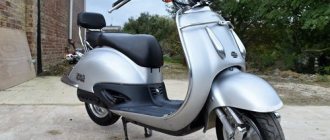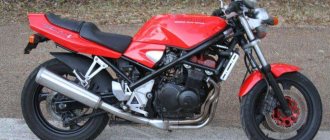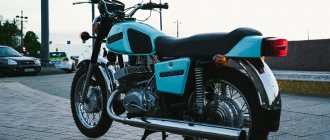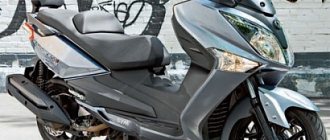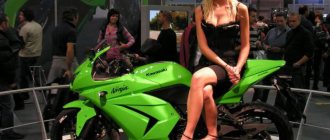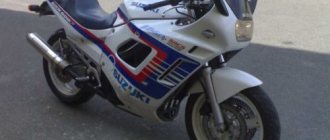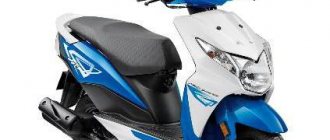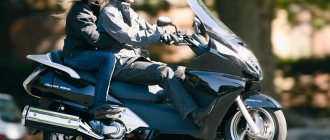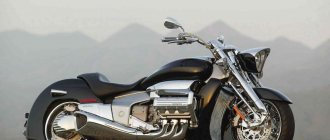History of origin
Of course, it is important to familiarize yourself with the emergence of such a model for a more understandable perception. Suzuki Adress 110 first appeared in 1986 and is considered one of the first models of the Japanese company. At that time, the scooter was considered the best in many respects, and its great popularity was due to its very affordable cost. The scooter also gained popularity due to its modern design, which competitors could not boast of at that time. For the city it was the best representative, reliable, maneuverable and inexpensive. In 1991, they decided to suspend production.
Soon, from 1998 to 2003, Suzuki again began producing the scooter, which received an updated design, new characteristics and was an ideal representative of medium-sized scooters. Speed and agility have been increased by installing a sports engine using well-known 2-stroke technology.
Reviews of Honda Dio Rating: 4.1 out of 5 13 reviews found
15.06.2008
Review of HONDA DIO 35sr I owned this scooter for about 2 months. (3000-3500 km) Liked it: I really liked the power of the scooter, in the absence of tuning, on a standard 50cc you could safely race with any car from the start, even with a powerful foreign car (very uplifting), but only up to 30 km/h, there was a speed drop due to the variator. Even on a car with wheels trailing, you overtake it))) I liked the build quality, I took a scooter with a mileage of 15-25 thousand (the speedometer just doesn’t show more than 9999) The condition is perfect, the plastic is high-quality and durable, the condition of the scooter itself from Japan is close to excellent. There are no problems with spare parts. Most spare parts are available in Moscow. For 3000k.m. I only changed consumables, oil, battery, pads, spark plug, tire, cleaned the carburetor) Nimble in traffic jams, you can drive in very narrow places. I didn’t like: 1. Dimensions a) Scoot for one, there is no legroom for the second passenger (very. not comfortable), the seat will allow two people to sit. b) The scooter is low, or rather the steering wheel, the legs rested on the steering wheel and did not allow normal maneuvering because of this. (I had to adapt) 2. Brakes. The gas handle is VERY sensitive, the brake of the front wheel is located on it, when you need to brake sharply, the gas handle does not have time to fully return, you press the front brake, the front wheel skids, the rear pushes forward (since the gas handle has not yet been released), you you fall. To learn how to use such a system well, you need experience, that is, professionalism. It can be corrected by good tension on the throttle, expensive front tires, and driving experience. In general, I have very positive memories and a feeling of quality and speed. The current is small) P/S In this season took the Chinese. I went for two days (200 km), so far I’m a little disappointed. I have a keeway flah 50, mileage is 2000 km, such a beautiful big scooter. If you compare with the Japanese, the acceleration is sooooooooooooooooooooooooooooooooooooooooooooooooooooooooooooooooooooooooooooooooooooooooooooooooooooooooooooooooooooooooooooo by 40 on the Japanese one, it seems you can do it twice. (in the technical data sheet 2.5 hp, on the Internet it goes up to 4.5)) But it is very comfortable, especially when compared with the Japanese. With excellent brakes. Two people can sit comfortably on it. The build quality is poor, the bolts themselves somehow unscrew and get lost. The plastic is squishy, in two days of use the rear spoiler, also known as the handle, broke in three places). There is a big problem with spare parts for this model, there is little useful information. For a full description of the keeway flash, see another section. I hope I could help you with something.
Specifications
The main advantage of the scooter is its engine. The model is equipped with an F129 engine, which has a volume of 113 cc and a power rating of 11 horses. A traditional two-stroke system is used, 1 cylinder. The maximum speed limit was set at 100 km/h, but some craftsmen were able to reach 110 km/h.
Increased performance made it possible to increase the fuel tank capacity to 6 liters, and low fuel consumption allows you to drive for a long time around the city or over short distances. Engine cooling is standard air, reaching 6,000 rpm. There is an installed oil tank, capacity 1.3 liters.
The dimensions of the Suzuki Adress 100 are slightly larger than other single seat scooters. But this is due to the presence of a 1.5-seater seat and a good engine. As a result, the length of the scooter was 1,855 mm with a wheelbase of 1,256 mm. The model is equipped with rims with a diameter of 12 inches. All this allowed the scooter to weigh 90 kg.
Suzuki Address V125
I will report further. I have already driven 10 thousand km across Russia. I travel in the cold. The scooter is still trouble-free, no unnecessary sounds, rattling, knocking, noise or vibrations have appeared. It starts up just as well, the maximum speed is the same, the traction characteristics have not changed. Consumption is the same as it was (within 3 liters per hundred square meters). The sub-section is still alive, although the exploitation is very extreme. I drive as fast as possible, with full throttle, and don’t slow down on bumps. Over the entire run of the scooter, I changed the front pads, did nothing else, change the oil every 4 thousand km, change the paper oil filter every 8 thousand km. I clean the air filter when changing the oil, that is, also after 4 thousand km. The battery has never been discharged, I start it exclusively with electric power. starter. I haven’t opened the variator cover yet, I don’t know the condition of the belt and weights, and not a single plastic element has ever been unscrewed on the scooter, everything is in its original form, all the screws are in place. In short, no traces of use are noticeable. I consider this an excellent indicator of the quality of Japanese scooters. So guys, if you see a Japanese scooter with a mileage of 14 thousand km and the tires are worn out, the brake disc is worn out, something is rattling, and most importantly the suspension is dead, then you are being deceived one hundred percent, the mileage is twisted. For 14 thousand km, it is impossible to bring a brand new Japanese scooter to the condition in which they are sold on the diamond under the guise of 14-20 thousand km.
There are already more than 15 thousand km on the odometer, I decided to open the variator cover for the first time. I was very pleased with the result. Yesterday I opened the variator for the first time. It turned out to be very convenient to fix the clutch bell due to the design of the cover, I won’t explain the intricacies, just know that it’s very easy to unscrew the rear nut without additional tools. Further, I was pleased with the internal design, the rear torque drive has a huge diameter, much larger than that of the 110, the variator has very large and powerful sliders, the variator bushing is also very powerful. The weights are much larger in diameter than on the 100 and 110 addresses. The scooter has covered an honest 15 thousand km, the belt is in excellent condition, the weights are slightly worn, barely noticeable, the torque driver is still full of lubricant, white in color, and there is a very minimal amount of dust from the belt. In general, I realized that it makes sense to go there only after 30 thousand km, so next time I will open the variator cover at 30 thousand km. Conclusion, the address v125 has been noticeably modernized in the direction of resource, unlike previous generations, and now I can say with complete confidence that if you bought a scooter with 15 thousand miles on it, and there are some traces of wear in the variator, it means the mileage is worn out, because it’s a fresh Japanese scooter with such mileage, practically like new. You may think that I use it carefully, but no, I push the scooter to the maximum, full throttle, always, I don’t slow down on bumps, I’m surprised at how it can withstand all this. I still change the oil every 4 thousand km.
Unfortunately, today I fell into a huge deep hole, it was impossible to see in the puddle, the rear disc of the wheel was dented very badly, the tire went flat instantly, tomorrow I will straighten it.
I continue the story about my moped. At 24,500 km the speedometer cable broke. I put it in Chinese for 60 rubles, I only changed the inner core without a shirt. At 25 thousand I changed the rear tires, the factory ones held up well, they didn’t have time to dry out, but there was no tread at all and they punctured often, since they were already very thin. at 26 thousand, to my surprise, the front wheel bearings completely fell apart, I changed the bearings, easily bought them in a store for 100 rubles. It was not difficult to change, I consider it an accident because this has never happened on my mopeds. By the way, I have already replaced 2 bulbs in the headlight, now there is a third one, and the high beam in it burned out a long time ago, I noticed that it burns out from strong shaking if you drive on a terrible road. I have already changed 5 sets of brake pads; Chinese pads for 60 rubles last about 4 thousand. At 27 thousand I replaced the rear ones, although they didn’t look particularly worn, but they were no longer slowing down. By the way, the suspension stopped working fully at about 26 thousand kilometers. The engine's thrust hasn't decreased one bit, the dynamics are good, the maximum speed has dropped, now it's problematic to accelerate a hundred, I think it's because of the belt. At the moment, the mileage is 31,000 km, I recently did an inspection of the variator, the belt is slightly cracked on the teeth, but I don’t think it will be possible to roll this belt, because in this condition it can travel for another 20-30 thousand, it is more likely to wear off in thickness than to break. The weights are in good condition, the clutch too, I lubricated the torque driver three times with the original lubricant, so I can’t say what would have happened if I hadn’t done this.
I didn’t adjust the valves, I checked the gap at 20 thousand, it’s kind of painfully microscopic, but since the scooter is driving well, I thought that it’s not worth touching them. Consumption on the highway was recently measured at a speed of 60 km/h and clearly consumes 1.9 liters, the documents say 1.92 l/100km. By the way, the fork works great, the seals are in order, it doesn’t hit bumps. The plastic also does not play, does not creak or rattle. Although when starting off there was a certain sound from the variator, after inspecting and cleaning the clutch pads with a special product, the sound completely disappeared, the clutch began to work like new. I've been using Mobil 1 5w40 engine oil from the very beginning. Over 4 thousand km, I add about 100 grams.
According to general impressions, the scooter is in excellent technical condition, but I won’t lie, as someone who has been using it “from new,” I still feel the difference, the suspension mainly lets you know that the scooter is used and the wheels are dented in places. But it is IMPOSSIBLE to say that the scooter is TIRED.
Igor
Scooter: Honda Dio AF 34
Pros: Playful, quiet, low fuel consumption.
Cons: inconvenient for two, incorrect trunk location.
This is my first scooter, so there’s nothing to compare it with, but you can still draw certain conclusions. I purchased a scooter in 2010, and then I immediately liked it for several characteristics. Firstly, it has a rather modern appearance, and secondly, my purchase was very neat and well-groomed.
During its operation there were very few repairs, that is, there were only minor breakdowns, and even then they could be easily fixed, because the scooter itself is very simple in design and details. This model does not have any complex elements; removing the engine or other parts is as easy as shelling pears.
Exploitation. It's a pleasure to ride. Once again I am convinced that the scooter is reliable even on long trips, and the best comfort is provided by a comfortable seat. There is almost no noise when driving, that is, everything works like a clock. Moped control is simple. Even a child can figure it out.
Paul
Scooter: Honda Dio AF 34
Pros: low fuel consumption, beautiful design, easy operation, low price.
Cons: impossible to drive in winter.
Hello, I’ll leave my opinion on what my Honda Dio scooter is, about which I found only positive reviews. And my review is also positive, I’ll even say more, I think this model is the best among Japanese small-capacity scooters. So, as a frequent user of vehicles, I needed a scooter with low fuel consumption, and friends advised me to take the Honda Dio AF 34. Its price was low, so I bought it used, but in excellent condition. I really liked the first days of use, because the scooter was maneuverable, it didn’t skid, and the maximum speed was about 60 km per hour. During the first year there were no repairs, for which I give it a huge plus. The only repair was a broken camera. Driving around the city is just a pleasure, because not a single traffic jam is a hindrance for a scooter.
I also liked the fact that despite the small size of the scooter, I could easily seat one passenger, and at the same time my Honda could easily reach 55 km/h. And at the end of the review, I recommend that in case of a breakdown, buy only original spare parts, because with them your scooter will forget about repairs for a long time.
